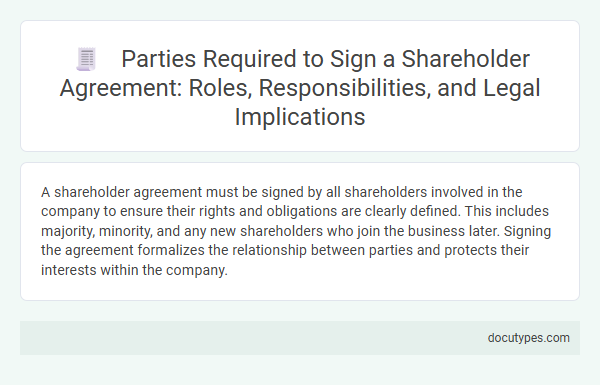A shareholder agreement must be signed by all shareholders involved in the company to ensure their rights and obligations are clearly defined. This includes majority, minority, and any new shareholders who join the business later. Signing the agreement formalizes the relationship between parties and protects their interests within the company.
Introduction to Shareholder Agreements
| Introduction to Shareholder Agreements |
|---|
| A shareholder agreement is a legal contract among a company's shareholders defining their rights, responsibilities, and obligations. This document regulates the management of the company, decision-making processes, and the relationship between shareholders. Establishing clear terms prevents disputes and protects both individual and collective interests within the corporation. |
| Which Parties Must Sign a Shareholder Agreement? |
| All shareholders of the company are typically required to sign the shareholder agreement. This includes founders, investors, and any individuals or entities holding equity interests. Signing by all parties ensures enforceability and uniform application of the agreement's provisions. In some cases, future shareholders may also be bound by the agreement through a mechanism called "notify and agree." |
| Significance of Signatories |
| The signatories' commitment secures the legal framework governing share transfer restrictions, voting rights, dividend policies, and dispute resolution procedures. Proper execution by all shareholders establishes transparency and trust, reducing potential conflicts and aligning shareholder expectations. |
Defining the Key Parties in a Shareholder Agreement
A shareholder agreement is a crucial document that governs the relationship between company shareholders. It outlines the rights, responsibilities, and obligations of each party involved.
The key parties required to sign a shareholder agreement typically include all shareholders holding equity in the company. This ensures that every stakeholder is legally bound by the terms and provisions outlined in the agreement.
Legal Significance of Party Inclusion
Who must sign a shareholder agreement for it to be legally effective? All parties holding shares in the company must sign the agreement to ensure their rights and obligations are clearly defined and enforceable. Including every shareholder protects the company from future disputes and validates the agreement under corporate law.
Directors vs. Shareholders: Who Must Sign?
A shareholder agreement is a critical document that governs the relationship between shareholders and the management of a company. Understanding who must sign this agreement is essential for its legal effectiveness and operational clarity.
- Shareholders Must Sign - All parties holding shares in the company are required to sign to ensure their rights and obligations are clearly defined.
- Directors Typically Do Not Sign - Directors are not usually signatories unless they are also shareholders because the agreement primarily addresses shareholder interests.
- Exceptions for Director-Shares - Directors who hold shares must sign the agreement to align their management role with their shareholder rights.
Role of Minority and Majority Shareholders
A Shareholder Agreement requires signatures from all parties holding shares in the company, ensuring both minority and majority shareholders are legally bound by the terms. Majority shareholders typically have the power to influence decisions, making their consent crucial for the agreement's validity.
Minority shareholders' signatures protect their rights and provide assurance that their interests are safeguarded within the company's governance. You should understand that their role, while limited in voting power, is essential for balanced corporate control and dispute resolution.
Third Parties and Their Involvement
A Shareholder Agreement must be signed primarily by the company's shareholders to ensure clarity and enforceability of ownership rights and responsibilities. Third parties, such as investors, advisors, or legal representatives, may need to sign if their involvement impacts shareholding conditions or if they act as guarantors or trustees. Your specific agreement could require signatures from these third parties to validate certain provisions and protect all parties' interests.
Responsibilities of Signatories
Parties involved in a shareholder agreement must include all key stakeholders to ensure clarity and legal enforceability. The responsibilities of signatories define the rights and obligations that each party agrees to uphold.
- Shareholders - Shareholders must sign to confirm their commitment to the company's governance and ownership rules.
- Directors - Directors sign to acknowledge their duties and the operational guidelines dictated by the agreement.
- Investors - Investors sign to protect their investment interests and secure voting rights within the company.
Your signature signifies acceptance of all terms and confirms your role in maintaining company integrity.
Consequences of Excluding a Party
All shareholders involved in a company must sign the shareholder agreement to ensure legal enforceability and protect their rights. Excluding a party from signing can result in that party not being bound by the agreement's terms, leading to potential disputes and inconsistencies in decision-making. Such exclusion may weaken the agreement's overall effectiveness and create vulnerabilities in corporate governance.
Addressing Changes in Shareholder Structure
Shareholder agreements must be signed by all initial shareholders to ensure clear governance from the outset. The agreement should also outline procedures for addressing any future changes in the shareholder structure.
- Initial Shareholders - All founding shareholders must sign to formalize rights and obligations from the beginning.
- New Shareholders - Any new shareholders joining after the agreement's execution are required to sign to remain bound by its terms.
- Shareholder Changes Protocol - The agreement must specify how transfers, sales, or issuance of new shares affect existing shareholders and require obtaining signatures or consents.
Which Parties Must Sign a Shareholder Agreement? Infographic

